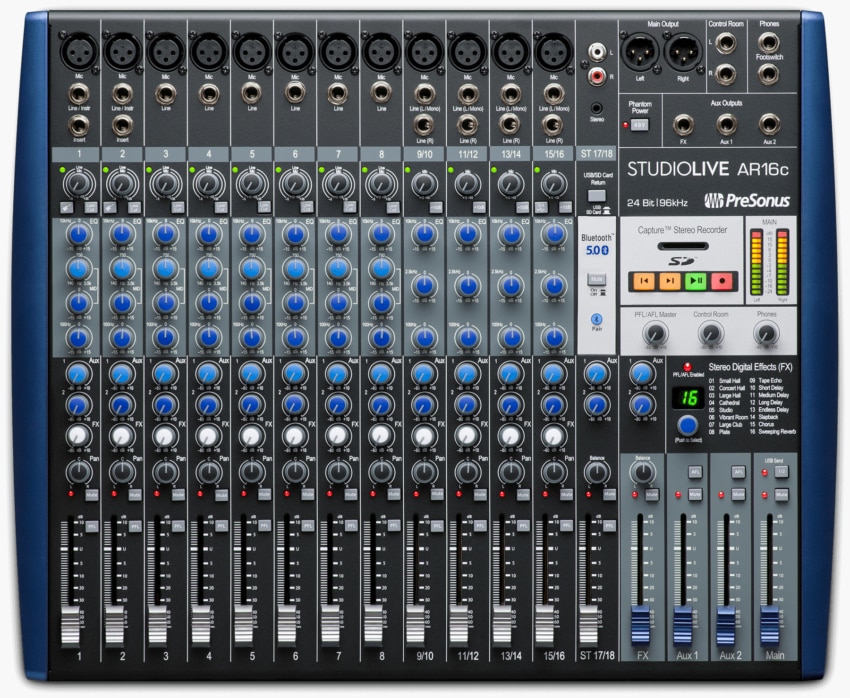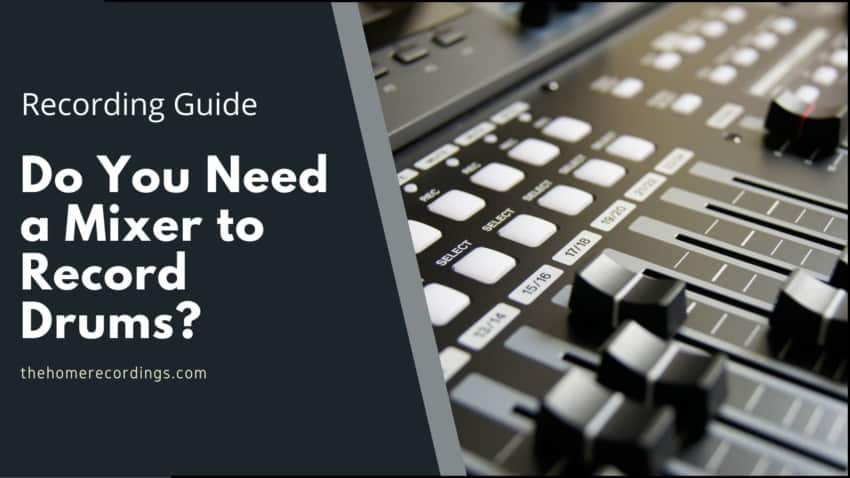This is a very valid question since one could assume that mixers offer more inputs, in general, than audio interfaces, right?
However, it’s definitely not the case and I’ll go into much more detail in this article and give you some insight on whether you should use a mixer or an audio interface to record drums.
In short; The ideal mic number is 8 because this allows you to individually record most pieces of the kit and process each of them separate from the rest. Recording an entire drum-kit with just one mic is also possible and can yield great results as well, if done properly.
Now, without any further ado, let’s get into the article!
Do You Need a Mixer to Record Drums?

While an audio mixer is an astute tool for recording drums, it is not the exclusive one. Keep in mind that an audio interface can also get the job done. When deciding between a mixer and interface, ask yourself: am I actually going tomix with this mixer? Don’t be dazzled by a mixer’s pretty pots and flashy faders, if you’re doing all your mixing in the box an interface is the way to go.
Perhaps you’re simply just looking for something to help you capture the groove of a neighbor-stressing jam session, an all-in-one portable recorder could be exactly what you need.
If I had to pick one, I would recommend to you the Zoom H2n. It’s an excellent piece of kit that has 5 built-in microphones which can record using X-Y and mid/side techniques. Zoom’s powerfully petite product is a steal at $170.
Maybe though, you have given it a thinking over; you are positive a USB mixer is the trusty tool to transcribe your tub thumping. Just be aware that some mixers will only allow you to record the 2-track stereo mixdown, while others let you record all inputs to individual tracks (i.e., multitrack). This completely affects your future processing capabilities since you won’t be able to EQ, compress, etc. each track individually.
How Many Inputs Do You Need to Record Drums?
As you can imagine, the number of inputs needed to record percussion varies greatly. You can go as little or large as you like; Mike Portnoy (Dream Theater, The Neal Morse Band) reportedly uses 23 microphones in his home studio while laying down his tracks.
A common method recording engineers use involves recording each element of the kit with 2 microphones. Mics are placed on the top and bottom of the toms and snare, along with one outside the kick drum to capture the low-end thud, and another inside of it to capture the beater attack. Cymbals may also be spot-mic’d, and/or 2 overhead microphones are used to capture them and provide a reinforcement of the entire kit.
I would suggest 8 inputs as a great target to aim for. There are countless ways you could make this number work. The previously mentioned set-up, minus the bottom mics for the toms and just a single overhead, is the first way that comes to mind.
On the other end of the spectrum, we have the technique of using a single microphone to record the entire kit.
The single-mic setup is ideal for people looking to avoid the phase issues of a multi-mic setup. It completely negates this issue and helps you focus more on what’s really important: getting the best performance out of the drummer.
The age-old adage of less is more also rings true with this technique; Gabriel Roth (Amy Winehouse, Michael Bublé) frequently uses just one mic to create his retro minimalistic Motown vibe, and Tchad Blake (The Black Keys, Los Lobos) has been known to have just one in the room.
And the last but certainly not least reason for using a single mic: financial reasons! Audio equipment is expensive, but the art of sound recording is not exclusively for the gentry; Don’t be afraid to let your SM57 carry the full load while saving for the future.
How to Record Drums with One Mic
There are 2 main factors that come into play when trying to achieve a quality recording of drums with one microphone.
The first one is being aware of the limitations it places on your recording and future mixing. If you’re recording a drummer who tends to give their cymbals an overzealous whip, the solution for this problem is to face it head on: tell them!
Getting the performer to be aware of these unbalances will improve their performance and your recording tenfold. I have left a link to a great video below which goes over the concept of a performer’s “self-mixing”:
The 2nd factor to be aware of is microphone placement. Although experimentation and attentive ears are always an engineer’s best friend, there are some tried and true techniques I can recommend to you.
A commonly used method is to bring the microphone roughly 5 feet back from the kit and point it towards the drummer’s chest. This captures a great full-bodied image but is not ideal for every room due to acoustics.
There is also a great technique which I highly recommend which goes by many names (Tchad Blake technique, Wurst technique, knee mic… take your pick).
You take a cardioid microphone and place it above the kick, let it slightly peek out over the batter side and aim it towards the snare drum. This placement will provide you with an astoundingly balanced sound. I have provided a link below to a clear demonstration of this method:
What Mixer Should You Use to Record Drums?
This is another question people ask which has a highly variable answer. I have listed some examples of mixers in which my opinion are ideal for drum recording.
The Presonus Studio Live ARc series is a fantastic set of analog mixers which offer multitrack recording. There are 3 different models on the market: the AR8c, AR12c, and AR16c.
The difference in these mixers is exclusively the channels available to you, they all feature the same coherent XMAX preamps and fantastic onboard FX processing.
Zoom’s LiveTrak series is a great set of modern digital mixers with multitrack recording. The L-8, L-12, and L-20 all offer transparent preamps, a built-in metronome, onboard FX, a SD card recorder, and multiple custom headphone mixes.
The L-12 and L-20 offer a talkback microphone, while the L-8 can either be USB bus powered or even AA battery powered!
If you’re looking for something more budget friendly, I recommend Allen & Heath’s ZEDi 10. It offers 4 mic/line inputs and two stereo TRS inputs, with GSPre preamps. The ability to record its tracks dry or wet, plus its rugged exterior makes the ZEDi 10 a great contender.
All of these mixers can be found in my article about mixers that can record multitracks over USB.
What Audio Interface Should You Use to Record Drums?
There are a wide range of interfaces available which would be suited for recording drums. Again, your desired number of inputs as well as the quality of the hardware is what you want to keep an eye on.
The Focusrite Scarlett 18i20 features 8 XLR/TRS inputs, 10 line-level outputs, 2 headphone outputs, attenuation pads, and a talkback microphone. The I/O capabilities, professional sound quality, and its fair price-tag make the 18i20 an attractive choice.
Presonus’ Studio 1824c is another interface you should keep in mind. It’s strikingly similar to the aforementioned 18i20, where it differentiates most from it is with its preamps.
Presonus’ XMAX Class A preamps offer a transparent flavor that would please the eardrums of many a drummer’s ear.
Here’s a comparison article between the 18i20 and the 1824c that may help you out!
Having an interface with a ton of analog inputs to record a kit is no longer necessary thanks to ADAT digital inputs. ADAT allows you to send numerous channels of audio from external preamplifiers to your audio interface all through one tidy cable.
The Audient iD14 MKii is an affordable interface which only has 2 analog inputs, but can expand itself to allow 10 extra inputs by connecting it to an 8-channel preamp, thanks to ADAT.
Perhaps a minimalistic recording set-up is what you’re aiming for, or you’re just on a tight budget. Focusrite’s Scarlett 2i2 is a 2-input interface which gives you access to their renowned preamps and converters without having to fork out a ton of cash.
Another option would be something like the Behringer UMC204HD, and you can find a comparison between the two interfaces here.
How to Record Drums to Your Computer
The first thing you need to do is connect your audio hardware and PC with the provided cable (generally USB).
Next, you will install the necessary audio driver for your interface or mixer to function with your computer.
You may also have to install some sort of control software which is used for routing inputs and outputs. This is more common with interfaces, but you will find mixers with this requirement as well.
You will then open your DAW of choice and its preferences window. From there you will be able to select the corresponding audio driver and interface/mixer.
Next, connect your microphones to your interface/mixer’s inputs.
Now select on each individual track of your DAW which input you would like it to receive a signal from.
Arm your tracks, dial in your hardware’s preamps, hit record, and let the games begin!
A Quick Recap:
- Connect your interface/mixer to your computer with provided cable (e.g., USB, FireWire).
- Install driver and control software.
- Open your DAW and its preferences window.
- Enable your audio driver and hardware.
- Connect microphones to hardware.
- Select on each track which input you would like it to correspond to.
- Arm tracks and adjust preamplifiers.
- Hit record and enjoy yourself!
Conclusion
In general, I would recommend most people to go with an Audio Interface and not a mixer mainly because of budgetary reasons, since mixers that can record multitracks directly to your PC are generally much more expensive.
If you’re just getting started, try the 1 mic approach. I assure you that you’ll be surprised at how well your drumkit can sound when just recorded with one mic. I sometimes do that when recording a friend’s drumkit and it works really well!
I hope this information was useful!
Have a great day!
